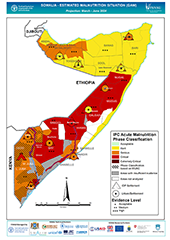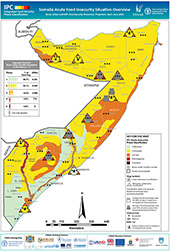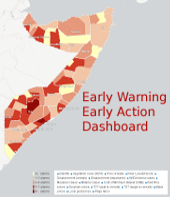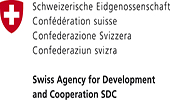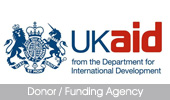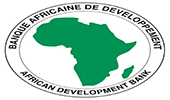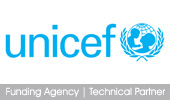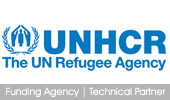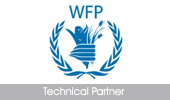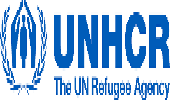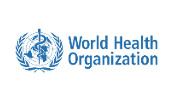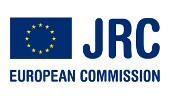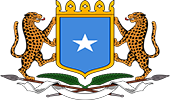Without urgent assistance, Somalia is projected to face its second F amine in just over a decade
Issued: September 5, 2022
Famine (IPC Phase 5) is projected to emerge in three areas of Bay Region, Somalia, in late 2022 in the absence of urgent, multi-sectoral humanitarian assistance. Although levels of acute malnutrition among children and the rate of hunger-related deaths have not yet met the IPC’s technical definition of Famine (IPC Phase 5), those thresholds are expected to be reached during the October to December 2022 projection period based on currently available information that minimal humanitarian food assistance will be delivered in these areas in November and December due to funding constraints.
The IPC analysis – conducted by experts across multiple agencies, including FEWS NET and FSNAU – has previously warned that up to 7.1 million people across Somalia need urgent, multi-sectoral assistanceii in order to treat and prevent acute malnutrition and reduce the number of ongoing hunger-related deaths.
Additionally, for months now FEWS NET, FSNAU, and IPC partners have been warning that eight areas in Somalia, inclusive of Bay, faced a Risk of Famine.iii Although provision of food and nutrition assistance is currently ongoing, levels of assistance have not kept pace with the scale and severity of needs amid a two-year drought, protracted conflict, and record-high staple food prices. Furthermore, weather forecasts predict an unprecedented, fifth consecutive poor rainfall season in late 2022 and increased chances of below-average rainfall in early 2023 in the eastern Horn of Africa, which would prolong extreme drought and its impacts well into 2023. In the absence of a significant scale-up of multi-sectoral assistance, a rapid acceleration of death and destitution is likely in Bay Region, at a minimum, and donor governments and humanitarians must act immediately to mitigate the impending loss of life here and across Somalia.
The areas where the multi-partner IPC analysis expects Famine (IPC Phase 5) to emerge include Baidoa and Burhakaba districts and settlements of newly arrived, internally displaced people (IDPs) in Baidoa town, all located in southern Somalia’s Bay Region. These are predominantly agropastoral areas where drought, conflict, and high food prices have decimated people’s ability to raise livestock, grow crops, and buy enough food to survive. According to FSNAU and partner field assessments, the sorghum and maize harvest in July was a near-total failure, amounting to just 13-20 percent of the 1995-2021 average; at the same time, at least 5-10 percent of the total livestock population in Bay Region has died from drought since mid-2021. Crop failure, limited cereal supply from neighboring countries, and global price shocks stemming from the Russia-Ukraine war have driven up the price of sorghum – the mainstay of the local diet in this area – by more than 200 percent compared to normal, exceeding prices observed during Somalia’s 2011-2012 Famine. Bay Region was part of the epicenter of the 2011 Famine that experts estimate claimed the lives of more than 250,000 people.
The large-scale loss of food and income over the past two years, due primarily to drought, has led to sharp increases in the number of people who regularly go a whole day without eating, have lost their livelihood, or have liquidated their assets in an effort to earn income for survival. Since early 2021, the drought has forced around 260,000 people in Bay Region to abandon their farms and move to displacement sites in search of food and aid. Household survey data collected by FSNAU and partners in late June and July found that over 20 percent of the population in Baidoa and Burhakaba are currently experiencing large food consumption gaps or can only mitigate their hunger by selling off all of their assets, traveling to displacement sites in search of food aid, or begging for food. Furthermore, by July 2022, acute malnutrition levels among children under five had reached 24.9 percent among rural populations and 28.6 percent among newly-arrived IDPs, while mortality levels reached 1.69 deaths per 10,000 people per day among rural populations and 1.11 deaths per 10,000 people per day among newly-arrived IDPs. These results, which are in the presence of food assistance reaching over 25 percent of the population, are indicative of Emergency (IPC Phase 4) outcomes and are nearing the Famine (IPC Phase 5) thresholds.
Moreover, conditions for crop and livestock production are expected to remain extremely poor until at least the start of the next rainy season in April 2023, if not longer, leading to further loss of livelihoods. Forecasts show high confidence in a below-average October to December 2022 deyr rainfall season; based on rainfall performance in years with similar climate conditions, rainfall in southern Somalia is likely to be as low as 40 percent below average, commonly characterized as a failed rainfall season. Current climate conditions not only mirror those of 2010, which precipitated the last Famine (IPC Phase 5) in Somalia, but also come on the heels of four consecutive poor rainfall seasons. A failed rainfall season in late 2022 would leave no prospects for recovery until at least the start of the next rainfall season in April 2023. However, empirical analysis of prevailing climate conditions further suggests increased chances for a sixth poor season in April-June 2023.
In the absence of a sustained scale-up of multi-sectoral assistance, a rapid acceleration of death and destitution in the coming months is likely as more and more households exhaust their last options for survival. WFP has reported it will face a pipeline break for its cash-based transfer response starting in October, with a full break in November and December. Due to considerable humanitarian access constraints in conflict-affected areas of southern Somalia, humanitarian actors consider in-kind food assistance as not a viable modality for food assistance in this area. While food assistance is expected to continue through October, sustaining Emergency! (IPC Phase 4!) outcomesiv, Famine (IPC Phase 5) is expected to occur among rural and IDP populations in these two districts in the absence of sustained assistance in November and December. Without interventions, there is the potential for Famine (IPC Phase 5) to continue into 2023.
It is critical to note that even if the technical thresholds for Famine (IPC Phase 5) are not reached within this period, a large-scale humanitarian response is still critically needed to treat and prevent acute malnutrition among children and limit hunger-related deaths that occur amid Crisis (IPC Phase 3) and Emergency (IPC Phase 4) outcomes. Given that households in Bay Region and across Somalia have sustained food consumption gaps for many months, the accumulation of deaths over time could easily surpass those that occur during a shorter period that meets the technical definition of Famine (IPC Phase 5).
FEWS NET and FSNAU: Somalia Food Security Alert: Without urgent assistance, Somalia is projected to face its second Famine in just over a decade, September 2022.
To download the full report click here
